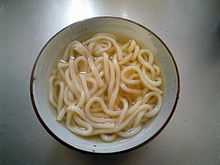Udon
| Udon | |
|---|---|
|
Kake udon | |
| Type | Japanese noodles/noodle soup |
| Place of origin | Japan |
| Serving temperature | Hot |
| Main ingredients | Noodles (wheat flour), broth (dashi, soy sauce (shōyu), mirin), scallions |
|
| |
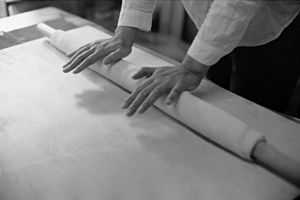
Udon (饂飩, usually written as うどん) is a type of thick wheat flour noodle of Japanese cuisine.
Udon is often served hot as a noodle soup in its simplest form, as kake udon, in a mildly flavoured broth called kakejiru, which is made of dashi, soy sauce (shōyu), and mirin. It is usually topped with thinly chopped scallions. Other common toppings include tempura, often prawn or kakiage (a type of mixed tempura fritter), or aburaage, a type of deep-fried tofu pockets seasoned with sugar, mirin, and soy sauce. A thin slice of kamaboko, a halfmoon-shaped fish cake, is often added. Shichimi can be added to taste.
The flavor of broth and topping vary from region to region. Usually, dark brown broth, made from dark soy sauce (koikuchi shōyu), is used in eastern Japan, and light brown broth, made from light soy sauce (usukuchi shōyu), is used in western Japan. This is even noticeable in packaged instant noodles, which are often sold in two different versions for east and west.
Origin
There are many stories explaining the origin of udon.
One story says that in AD 1241, Enni, a Rinzai monk, introduced flour milling technology to Japan. Floured crops were then made into noodles such as udon, soba, and pancakes which were eaten by locals. Milling techniques were spread around the country. In the Edo period, the thicker wheat noodle was generally called udon, and served with a hot broth called nurumugi (温麦). The chilled variety was called hiyamugi (冷麦).
Another story states that during the Nara period, a Japanese envoy was introduced to 14 kinds of confection while being in China during the Tang Dynasty. One of them was called sakubei (索餅), which was listed as muginawa (牟義縄) in Shin Senji Kyo (新撰字鏡), a dictionary which was published in the Heian Era. The muginawa is believed to be an origin for many kinds of Japanese noodles. However, the muginawa in Shin Senji Kyo was made with wheat and rice flour.
Another story for udon claims that the original name of the noodle was konton, which was made with wheat flour and sweet fillings.
Yet another story says that a Buddhist priest called Kukai introduced udon noodles to Shikoku during the Heian Era.
In China, similar thick wheat flour noodles are called cūmiàn (simplified Chinese: 粗面; traditional Chinese: 粗麵). This flat pancake-shaped "noodle" was 2 to 3 mm in diameter with a miso-based soup. The Sino-Japanese characters for udon (饂飩) is similar to, but different from, the modern Chinese characters for a type of dumplings called wonton, which is 馄饨/餛飩 (húntun or húndun in Mandarin).
In Chinese, udon noodles are called wūdōngmiàn (乌冬面; 烏冬麵) or wūdōng (乌冬; 烏冬), and sometimes wūlóngmiàn (乌龙面; 烏龍麵), which has the same characters as those used in "Oolong" tea (乌龙茶; 烏龍茶; wūlóngchá), though there is no semantic relation between the two usages.
Kūkai, the Buddhist priest, traveled to China around the beginning of the 9th century to study. Sanuki Province claimed to have been the first to adopt udon noodles from Kūkai. Hakata claimed to have produced udon noodles based on Enni's recipe.
Dishes
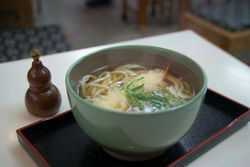
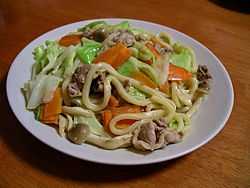
Like many Japanese noodles, udon noodles are served chilled in the summer and hot in the winter. Toppings are chosen to reflect the seasons. Most toppings are added without much cooking, although some are deep-fried. Many of these dishes may also be prepared with soba.
Hot
- Kake udon (in Kantō) or Su udon (in Kansai): Hot udon in broth topped with thinly sliced green onions, and perhaps a slice of kamaboko.
- Kitsune udon: "Fox udon". Topped with aburaage (sweetened deep-fried tofu pockets).
- Tempura udon: Topped with tempura, especially prawn, or kakiage, a type of mixed tempura fritter.
- Tanuki udon ("Raccoon-dog udon") (in Kantō) or Haikara udon (in Kansai): Topped with tempura batter pieces.
- Tsukimi udon: "Moon-viewing udon". Topped with raw egg, which poaches in the hot soup.
- Wakame udon: Topped with wakame, a dark green sea vegetable.
- Karē udon: "Curry udon". Udon in a curry-flavoured soup which may also include meat or vegetables. Biei, Hokkaido is famous for a unique curry udon.
- Chikara udon: "Power udon". Topped with toasted mochi rice cakes.
- Stamina (sutamina) udon: "Stamina udon". Udon with various hearty ingredients, usually including meat, a raw egg, and vegetables.
- Nabeyaki udon: A sort of udon hot-pot, with seafood and vegetables cooked in a nabe, or metal pot. The most common ingredients are tempura shrimp with mushrooms and an egg cracked on top.
- Kamaage udon: Served in a communal hot-pot with hot water, and accompanied by a hot dipping sauce of dashi and soy sauce.
- Udon-suki: Udon cooked in the manner of sukiyaki.
- Yaki udon: Stir-fried udon in soy-based sauce, prepared in a similar manner to yakisoba. This originated in Kitakyushu of Fukuoka Prefecture. (Note that while yakiudon is made with udon, yakisoba is not made from buckwheat soba, but with steamed Chinese-style ramen.)
- Miso-nikomi udon: hard udon simmered in red miso soup. The soup generally contains chicken, a floating cracked raw egg that is stirred in by the eater, kamaboko, vegetables and tubers. The noodles are extremely firm in order to stand up to the prolonged simmering in the soup; additionally, the noodles do not contain salt, so as to avoid over-salting from the salt in the miso.
- Hōtō udon: a local dish of Yamanashi Prefecture, a type of miso soup with udon and vegetables.One of the significant difference between usual udon and Hōtō udon is salt. When you make Hōtō udon, you have not to add salts to its dough.
Cold
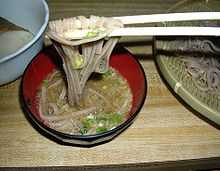
- Zaru udon: Chilled udon noodles topped with shredded nori and served on a zaru (笊 or ざる), a sieve-like bamboo tray. Accompanied by a chilled dipping sauce, usually a strong mixture of dashi, mirin, and shoyu. Eaten with wasabi or grated ginger.
- Bukkake udon: Cold udon served with thick dashi-broth.
- Hadaka udon (naked udon 裸うどん): Cold udon served on its own.
- Kijoyu udon: Served in a cold soup of raw (unpasteurized) soy sauce and sudachi (a type of citrus) juice, sometimes with a bit of grated daikon.
Regional varieties
There are wide variations in both thickness and shape for udon noodles.
- Inaniwa udon (稲庭うどん): a thin type from Akita Prefecture.
- Mimi udon (耳うどん, literally "ear udon"): a lucky preserved food in Kuzu, Tochigi. It looks similar to ears.
- Himokawa (ひもかわ): an extreme flat and wide type from Kiryū, Gunma.
- Hōtō (rarely 餺飥, commonly ほうとう): a flat and wide type, usually cooked with vegetables, particularly Japanese "kabocha" squash, from Yamanashi Prefecture.
- Kishimen (棊子麺, or more commonly きし麺): a flat type from the Nagoya.
- Ise udon (伊勢うどん): a soft type, usually eaten with sweet soy sauce, from Ise, Mie.
- In Kansai region, a soft and medium thickness type is popular.
- Sanuki udon (讃岐うどん): a thick and rather stiff type from Kagawa Prefecture.
- Hakata udon (博多うどん): a thick and soft type from the Fukuoka.
- Dango-jiru (団子汁): similar to the above Hohtoh, from Ōita Prefecture. Nominally a "dumpling soup", it resembles very thick, flat udon.
- Okinawa soba (沖縄そば): also called suba, a regional Okinawan noodle made by adding some vegetal ash to the flour, similar to how ramen is made. However, it is very similar to udon.
- There is also a dish called udon in Palau, because of the former Japanese administration. The broth is soy sauce–based like Japanese udon. However, as there were many immigrants from Okinawa, it uses less broth like Okinawa soba. Most notably, the noodle is that of spaghetti, as it is easier to acquire there.
-

Himokawa
-

Mimi udon
-

Kishimen
-
Ise udon
See also
- Cu mian, a very similar variety of noodle from China
- Pici, a similar variety of noodle from Tuscany
- Bucatini, another similar variety of noodle from Lazio
- Bigoli, another similar variety of noodle from Veneto
- Soba
- Sōmen
- Ramen
- Japanese noodles
References
- Tsuji, Shizuo. (1980). Japanese cooking: A simple Art. Kodansha International/USA, New York. ISBN 1568363885
External links
| Wikimedia Commons has media related to Udon. |
| ||||||||||||||||||||||||||||||||||||||||||||||||||||||||||||||||||
